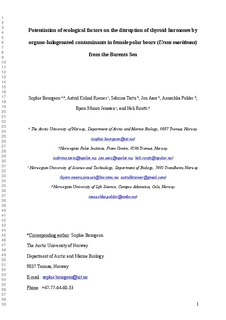Potentiation of ecological factors on the disruption of thyroid hormones by organo-halogenated contaminants in female polar bears (Ursus maritimus) from the Barents Sea.
| dc.contributor.author | Bourgeon, Sophie | |
| dc.contributor.author | Riemer, Astrid Kolind | |
| dc.contributor.author | Tartu, Sabrina | |
| dc.contributor.author | Aars, Jon | |
| dc.contributor.author | Polder, Anuschka | |
| dc.contributor.author | Jenssen, Bjørn Munro | |
| dc.contributor.author | Routti, Heli Anna Irmeli | |
| dc.date.accessioned | 2017-06-16T11:44:44Z | |
| dc.date.available | 2017-06-16T11:44:44Z | |
| dc.date.created | 2017-06-12T10:57:06Z | |
| dc.date.issued | 2017 | |
| dc.identifier.citation | Environmental Research. 2017, 158 94-104. | nb_NO |
| dc.identifier.issn | 0013-9351 | |
| dc.identifier.uri | http://hdl.handle.net/11250/2446273 | |
| dc.description.abstract | As apex predators, polar bears (Ursus maritimus) are among the most heavily polluted organisms in the Arctic. In addition to this anthropogenic stressor, climate warming has been shown to negatively affect their body condition, reproductive output and survival. Among potential underlying physiological mechanisms, thyroid hormones (THs), which control thermoregulation, metabolism and reproduction, can be affected by a variety of both natural and anthropogenic factors. While THs have been extensively used as proxies for pollution exposure in mammals, including polar bears, there is a lack of knowledge of their natural variations. In this context, we examined seasonal variations in body condition and circulating TH concentrations in free-ranging female polar bears. Females with variable reproductive status (i.e., solitary, with cubs of the year or with yearlings) were sampled from locations with contrasted sea ice conditions. Furthermore, we studied THs in relation to levels of organo-halogenated contaminants. As predicted, solitary females were in better condition than females caring for offspring, especially in spring. In addition, TH levels were lower in autumn compared to spring, although this seasonal effect was mainly observed in solitary females. Finally, the negative relationships between organochlorine and perfluoroalkyl substances and some THs suggest a possible alteration of homeostasis of THs. Since the latter relationships were only observed during spring, we emphasize the importance of considering the ecological factors when using THs as proxies for pollution exposure. Yet, the combined effects of natural and anthropogenic stressors on THs might impair the ability of polar bears to adapt to ongoing climate changes. | nb_NO |
| dc.language.iso | eng | nb_NO |
| dc.publisher | Elsevier | nb_NO |
| dc.rights | Attribution-NonCommercial-NoDerivatives 4.0 Internasjonal | * |
| dc.rights | Attribution-NonCommercial-NoDerivatives 4.0 Internasjonal | * |
| dc.rights.uri | http://creativecommons.org/licenses/by-nc-nd/4.0/deed.no | * |
| dc.title | Potentiation of ecological factors on the disruption of thyroid hormones by organo-halogenated contaminants in female polar bears (Ursus maritimus) from the Barents Sea. | nb_NO |
| dc.type | Journal article | nb_NO |
| dc.type | Peer reviewed | nb_NO |
| dc.description.version | submittedVersion | nb_NO |
| dc.source.pagenumber | 94-104 | nb_NO |
| dc.source.volume | 158 | nb_NO |
| dc.source.journal | Environmental Research | nb_NO |
| dc.identifier.doi | 10.1016/j.envres.2017.05.034 | |
| dc.identifier.cristin | 1475304 | |
| dc.description.localcode | © 2017 Elsevier Inc. All rights reserved. This is the authors' accepted and refereed manuscript to the article. Locked until 11 June 2019 due to copyright restrictions | nb_NO |
| cristin.unitcode | 194,66,10,0 | |
| cristin.unitname | Institutt for biologi | |
| cristin.ispublished | true | |
| cristin.fulltext | original | |
| cristin.qualitycode | 2 |
Tilhørende fil(er)
Denne innførselen finnes i følgende samling(er)
-
Institutt for biologi [2512]
-
Publikasjoner fra CRIStin - NTNU [37186]

